God's Wife of Amun › Achaemenid Empire » Ancient origins
Articles and Definitions › Contents
- God's Wife of Amun › Who Was
- Achaemenid Empire › Antique Origins
Ancient civilizations › Historical and archaeological sites
God's Wife of Amun › Who Was
Definition and Origins
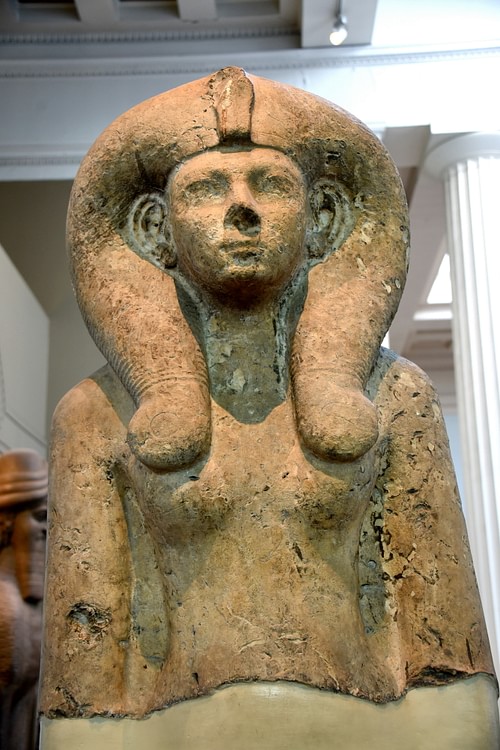
The position of God's Wife of Amun was one of the most politically powerful and spiritually significant in later Egyptian history.Elevated from a figurehead in the New Kingdom (c.1570-1069 BCE), the God's Wife of Amun would hold power equal to a pharaoh by the Third Intermediate Period of Egypt (c. 1069-525 BCE) when the God's Wife would rule Upper Egypt.
Although some scholars maintain that the position existed in the Middle Kingdom of Egypt (2040-1782 BCE), only the title is mentioned in that period and it was nothing exceptional. There were many 'God's Wives' and probably had been earlier. There was a God's Wife of Ra, a God's Wife of Ptah, and a God's Wife of Amun along with other deities' ritual wives.
These women were either the mother, wife, or eldest daughter of the king and would perform necessary rituals at ceremonies and festivals. From the beginning of the New Kingdom, however, this title would be imbued with greater power and significance. Inscriptions from the 18th Dynasty, such as the famous Donation Stele, attest to the great wealth and prestige of the God's Wives and later inscriptions make clear that the position only grew in power.
In the 20th Dynasty, Isis (also known as Iset and Aset), the virgin daughter of Ramesses VI (1145-1137 BCE) became God's Wife of Amun and, from then on, the position would be held by celibate women of royal birth, no longer wives or mothers of the king, by royal decree. Ramesses VI may have believed succession would go more smoothly if God's Wives were free to adopt a successor without considering familial obligations.
AHHOTEP I & AHMOSE-NEFERTARI
During the Second Intermediate Period of Egypt (c. 1782 - c. 1570 BCE), which followed the Middle Kingdom, Egypt was divided with no strong central government. The foreign Hyksos ruled in Lower Egypt, the Egyptians held Upper Egypt from Thebes, and the Nubians had the southern regions. The Theban prince Ahmose I (c.1570-1544 BCE) drove the Hyksos from Egypt, defeated the Nubians, and unified Egypt under his rule.
Ahmose I credited the god Amun with his victories but, significantly, also honored his mother Queen Ahhotep I (c. 1570-1530 BCE) who held the title of God's Wife of Amun (as inscribed on her sarcophagus). When Ahmose I led the army south to campaign against the Nubians, Hyksos sympathizers seem to have tried to overthrow his new administration and this rebellion was put down by Queen Ahhotep I.
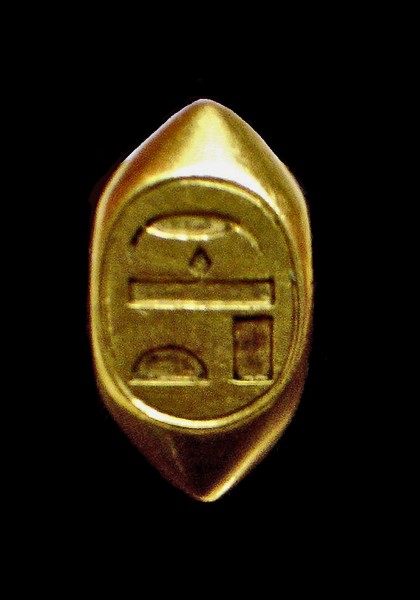
Ring of Ahhotep
Egyptologist Betsy M. Bryan observes how "Ahhotep apparently commanded the respect of local troops and grandees to preserve a fledgling dynastic line and she continued to function as king's mother well into the reign of Amenhotep I" (Shaw, 218). At some point she surrendered the role of God's Wife to her daughter, Ahmose-Nefertari, who was also Ahmose I's wife.
Prior to Ahhotep I, only two women are attested to as God's Wives of Amun: Sit-ir-bau and Ta-khered-qa, both of the late 17th Dynasty. Neither of these women is mentioned as wielding any considerable power, and the title may have been awarded posthumously. The God's Wife of Amun at that time would have played a role in certain rituals, and however important that role may have been, its influence began and ended with the ceremony.
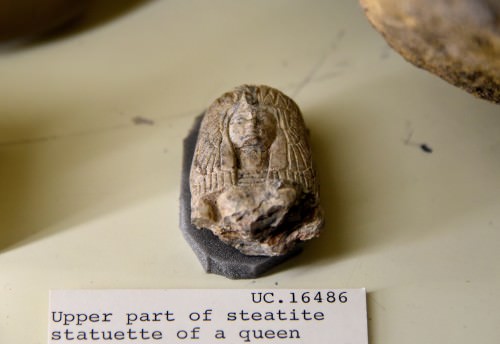
Statuette of Queen AHMOSE-NEFERTARI
THE NEW ROLE OF GOD'S WIFE
When Ahhotep I conferred the title on Ahmose-Nefertari, Ahmose I increased the power of the God's Wife dramatically and, perhaps, in a deliberate effort to diminish the power of the priests. The God's Wife was no longer a mere figurehead nor was she any kind of understudy for the king in times of crisis; now the God's Wife of Amun was effectively the female counterpart of the high priest. She was granted her own private income in compensation for performing rituals previously reserved for the high priesthood. Bryan identifies the duties of the position starting with Ahmose-Nefertari:
1. Participation in the procession of priests for the daily liturgies of Amun. She was shown accompanying the priests called "god's fathers," a general designation that could include the top four priests of the temple, known by numbered position, ie, "first priest," etc.2. Bathing in the sacred lake with the pure priests before carrying out rituals.3. Entering the most exclusive parts of the temple together with the high priest. This included the holy of holies.4. With the high priest, "calling the god to his meal," reciting a menu of food offering being presented to Amun.5. With the high priest, burning wax effigies of the enemies of the god to maintain the divine order.6. Shaking the sistrum before the god to propitiate him.7. Theoretically, as the "god's hand," assisting the deity in his self-creative masturbation. In this way and in her sistrum activity (a sexual allusion) she performed as the god's wife. (Bryan, 2)
These responsibilities and honors were rewarded with tax-exempt land, housing, food, clothing, gold, silver, and copper, male and female servants, wigs, ointment, cosmetics, livestock, and oil. While most of this payment was used in the performance of her duties, the lands would generate further revenue which would go directly to the God's Wife as her personal property, not to the temple.
GOD'S WIVES AFTER AHMOSE-NEFERTARI
The God's Wives who came after the reign of Ahmose I all held this same power and prestige to greater or lesser degrees.Although some of these women were the daughters of high priests, the majority were related to the king. In addition to the God's Wife, there were the honorary titles of Divine Adoratrice and God's Hand. These two lesser positions could be held by non-royal women, though usually they seem to have been filled with younger sisters or relatives of the God's Wife.
THE GOD'S WIFE OF AMUN WAS EFFECTIVELY THE FEMALE COUNTERPART OF THE HIGH PRIEST.
The responsibilities of the position of God's Hand are unclear as it is obvious that the God's Wife performed the function of God's Hand in the ritual act of creative masturbation. The Divine Adoratrice was a high priestess who assisted the God's Wife and presided over festivals and ceremonies. She seems to have held equal power to the highest priests of the temple and a Divine Adoratrice is known to have become a God's Wife a number of times.
For the most part, the dates of the women's lives below are unknown. The dates given are those of their fathers or husbands.Details of their duties as God's Wife are equally lacking and, except for notable exceptions, they are known only through their tombs. When a God's Wife date is known it is given below right after her name.
18TH DYNASTY
Sit-Kamose : Most likely a daughter of Kamose, brother of Ahmose I. Possibly awarded the title posthumously.
Ahmose-Meritamun : Also known as Meryetamun. Eldest daughter of Ahmose I and Ahmose-Nefertari. Succeeded Ahmose-Nefertari as God's Wife and was sister-wife of Amenhotep I (c.1541-1520 BCE).
Ahmose-Sitamun : A daughter of Ahmose I and one of his lesser wives. Her name means "Child of the Moon-Daughter of Amun." She was clearly quite important since a large statue of her was erected at Karnak but little is known of her.
Hatshepsut : (1479-1458 BCE) The daughter of Thutmose I and Queen Ahmose, Hatshepsut is the most powerful and successful female ruler of ancient Egypt. Shortly after she became pharaoh, she surrendered the title of God's Wife to her daughter Neferu-Ra to further consolidate her power.

Hatshepsut
Seniseneb : Not the same woman as the mother of Thutmose I and not an actual God's Wife but a Divine Adoratrice of Amun.She was the daughter of high priest and vizier Hapuseneb and his wife Ahhotep and began her career as a temple singer.Later married to Puyemra, a priest of Amun.
Isis : Also known as Iset, the mother of Thutmose III. Awarded the title of God's Wife posthumously among other honors bestowed by her son.
Sitiah : Also known as Satiah, the first wife of Thutmose III who was given the title of God's Wife by his mother Isis. She died and was succeeded by Merytre-Hatshepsut as Thutmose III's second wife.
Huy : The mother of Merytre Hatshepsut and a Divine Adoratrice. She may have been given the title posthumously and is known only from a statue showing her in a family setting with her grandchildren.
Merytre-Hatshepsut : Wife of Thutmose III and mother of Amenhotep II (1425-1400 BCE). She succeeded Sitiah as principal wife and God's Wife and is regularly depicted as a regal queen.
Merytamun : Also known as Meritamen and, to modern-day scholars, as Merytamun C (to distinguish her from her sister and others of the same name). She was the daughter of Tuthmosis III and Merytre-Hatshepsut.
Tiaa : The wife of Amenhotep II and mother of Thutmose IV (1400-1390 BCE).
Maetka : Not a God's Wife but Divine Adoratrice during the reign of Amenhotep III (1386-1353 BCE). Maetka was the wife of a man named Senena, the head goldsmith of Amun, who assisted in creating the sacred statuary and temple ornaments. It is probable that Maetka would have become God's Wife in any other era but the position fell out of favor during Amenhotep III's reign.
Maetka : Not a God's Wife but Divine Adoratrice during the reign of Amenhotep III (1386-1353 BCE). Maetka was the wife of a man named Senena, the head goldsmith of Amun, who assisted in creating the sacred statuary and temple ornaments. It is probable that Maetka would have become God's Wife in any other era but the position fell out of favor during Amenhotep III's reign.
Amenhotep III's wife Tiye (1398-1338 BCE) held all of the traditional titles associated with the queen but not God's Wife.Amenhotep III was an effective ruler who reigned over Egypt at one of its highest cultural and economic peaks and Tiye was a powerful presence at court. It is well established that the couple did not approve of the cult of Amun or its influence and Tiye would support her son Akhenaten (1353-1336 BCE) in abolishing the cult and reforming religious beliefs in Egypt.
No God's Wives are mentioned for the rest of the 18th Dynasty. Akhenaten, of course, had eliminated the office during his reign and his successors Tutankhamun (c. 1336-1327 BCE) and Horemheb (1320-1295 BCE) were too busy trying to repair the damage done to the state by Akhenaten's reforms to reinstate it or, possibly, the position was revived but not conferred.The God's Wife of Amun appears again in the 19th Dynasty with the same prestige as earlier.
19TH DYNASTY
Sitre : The wife of Ramesses I (1292-1290 BCE), who founded the 19th Dynasty, and the mother of Seti I (1290-1279 BCE).Possibly known as Tiy or Tiye before becoming queen and taking the title God's Wife.
Tuya : Also known as Mut-Tuya and Tuy, she was the wife of Seti I and mother of Ramesses II (1279-1213 BCE, better known as Ramesses the Great). She is depicted in statuary as a regal queen and God's Wife through a number of inscriptions and statuary but little is known of her life.
Nefertari : (c. 1255 BCE) Also known as Nefertari-Meritmut, wife of Ramesses II. She was highly educated and so was influential in her husband's diplomatic efforts and a great power at court. Ramesses II had the Temple of Abu Simbelconstructed in her honor and her tomb is the largest in the Valley of the Queens. She remains one of the most famous figures in Egyptian history.
Tuya : Also known as Mut-Tuya and Tuy, she was the wife of Seti I and mother of Ramesses II (1279-1213 BCE, better known as Ramesses the Great). She is depicted in statuary as a regal queen and God's Wife through a number of inscriptions and statuary but little is known of her life.
Nefertari : (c. 1255 BCE) Also known as Nefertari-Meritmut, wife of Ramesses II. She was highly educated and so was influential in her husband's diplomatic efforts and a great power at court. Ramesses II had the Temple of Abu Simbelconstructed in her honor and her tomb is the largest in the Valley of the Queens. She remains one of the most famous figures in Egyptian history.
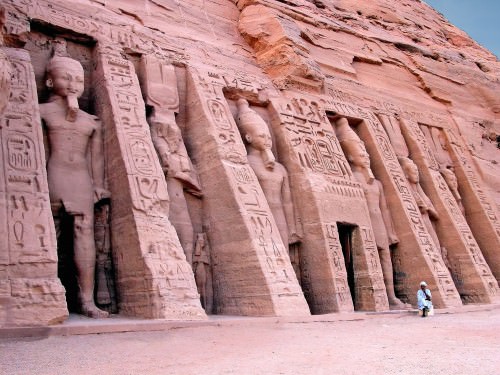
The Small Temple, Abu Simbel
Meritamen : Also known as Merytamun, the fourth daughter of Ramesses II and Nefertari. It is assumed that Meritamen received the title of God's Wife from Nefertari, but this is uncertain. It is only known she held the position of "Superior of the Harem of Amun-Ra" while Nefertari lived. Most likely, she became God's Wife when she was elevated by her father to Great Royal Wife following the death of Nefertari.
Twosret : Also known as Tawosret (1191-1190 BCE) was the step-mother of Siptah (1197-1191 BCE) who died at the age of 16. Twosret then ruled Egypt until her death when she was succeeded by Setnakhte (1190-1186 BCE) who founded the 20th Dynasty.
20TH DYNASTY
Isis-Ta-Hemdjert : The wife of Ramesses III (1186-1155 BCE) and mother of Ramesses IV (1155-1149 BCE). She conferred the title of God's Wife on her granddaughter Isis (daughter of Ramesses VI).
Isis : Also known as Iset and Aset, the daughter of Ramesses VI. She is the first known celibate God's Wife of Amun and initiated the policy which was adhered to from that time forward. God's Wives would henceforth be virgin daughters only, no longer wives or mothers.
Tyti : Possibly the wife of Ramesses X (1111-1107 BCE) but probably his maiden daughter. Very little is known of her.
Isis : Also known as Iset and Aset, the daughter of Ramesses VI. She is the first known celibate God's Wife of Amun and initiated the policy which was adhered to from that time forward. God's Wives would henceforth be virgin daughters only, no longer wives or mothers.
Tyti : Possibly the wife of Ramesses X (1111-1107 BCE) but probably his maiden daughter. Very little is known of her.
21ST DYNASTY TO THE INVASION
Maatkare : The daughter of the high priest Pinedjem I (1070-1032 BCE) and sister to the pharaoh Psusennes I (1047-1001 BCE). The cooperation of the high priest of Amun at Thebes and the king at Tanis during this time is well documented, though little is known of Maatkare's actual duties. She is best known from her tomb which contained her mummified pet monkey.
Henuttawy : The daughter of Pinedjem II (c.990-969 BCE) and his queen Isetemkheb.
Karomama : Also known as Karomama-Meryetmut and, to modern scholars, as Princess Karomama C, daughter of Osorkon II (872-837 BCE). Best known for her exquisite statue now in the Louvre, Paris.
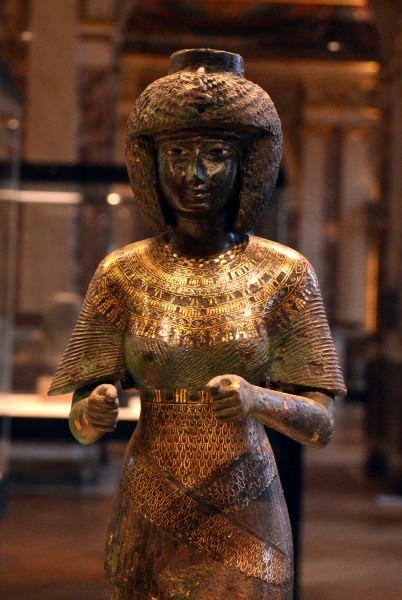
Queen Karomama I
Tashakheper : Another daughter of Osorkon II who does not seem to have held the title of God's Wife very long.
Shepenwepet I : The daughter of Osorkon III (c. 790 BCE) and Queen Karoatjet.
Amenirdis I : (c. 714-700 BCE) The daughter of Kashta (c. 750 BCE) and Queen Pebatjma, Sister of Piye (747-721 BCE) and his successor Shabaka (721-707 BCE). One of the most powerful of the God's Wives who effectively ruled Upper Egypt. She held the position of Divine Adoratrice before becoming God's Wife and High Priestess of Amun at Thebes.
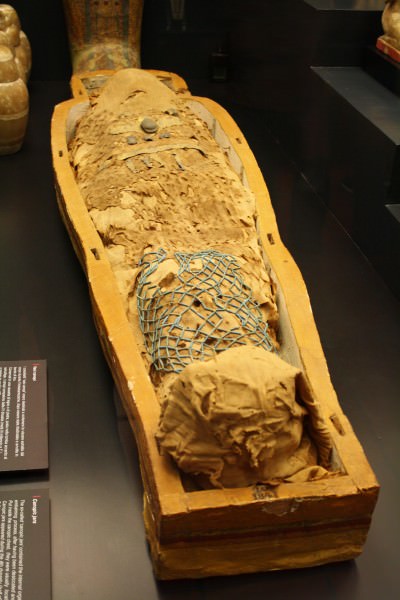
Mummy of Amenirdis
Shepenwepet II : The daughter of Piye and half-sister of King Taharqa (c. 690-671 BCE).
Amenirdis II : (c. 650-640 BCE) The daughter of Taharqa. She was selected as heir by Shepenwepet II but never actually occupied the position. Amenirdis II had adopted Nitokris I as her heir and the title passed directly to her when the Nubian rule in Egypt ended. Amenirdis II remained as the Divine Adoratrice to Nitokris I.
Nitokris I : (655-585 BCE) Also known as Neitiqert and Shepenwepet III, daughter of Psamtik I (c. 665-610 BCE) and his queen Mehytenweskhet. One of the wealthiest of God's Wives who ruled over seven districts in Upper Egypt and four in Lower Egypt and who commanded tribute of 420 pounds (190 kilograms) of bread, cereals, herbs, and milk daily from the priests of Amun as well as a monthly tribute of various foods and cattle (van de Mieroop, 275). She is among the most famous of God's Wives owing to inscriptions at Karnak, Abydos, and elsewhere and the Adoption Stele which recounts how Nitokris I became a God's Wife.
Shepenwepet IV : Most likely a daughter of King Necho II (610-595 BCE) and his queen Khedeb- neith -hirbinet.
Ankhenesneferibre : (c. 595-525 BCE) The daughter of Psamtik II (595-589 BCE) and his queen Takhuit. She ruled at Thebes until the Persian Invasion.
Nitokris II : The daughter of Amasis II (also known as Ahmose II, 570-526 BCE) who was chosen as Ankhenesneferibre's successor. She held the office of High Priestess of Amun at Thebes and Divine Adoratrice to Ankhenesneferibre. She is the last woman to be adopted as a successor to the title of God's Wife of Amun before the Persian Invasion.
THE PERSIAN INVASION
Amasis II was an exceptional military leader and administrator, but his son Psamtik III (526-525 BCE) was young and inexperienced when he came to the throne. According to Herodotus, the Persian king Cambyses II had sent to Amasis asking for one of his daughters as a wife but there was a long-standing policy in Egypt that daughters of royalty were not sent to foreign lands as wives.
Amasis II, therefore, could not comply but at the same time wished to avoid conflict, so he sent the daughter of a former ruler, Apries, instead. This princess of Egypt was deeply insulted by Amasis' decision and especially so because of the ancient Egyptian tradition which Amasis II had just ignored at her expense. When she arrived at Cambyses II's court, she revealed to him who she really was, and Cambyses II swore to avenge the insult of having been sent a 'fake wife.'
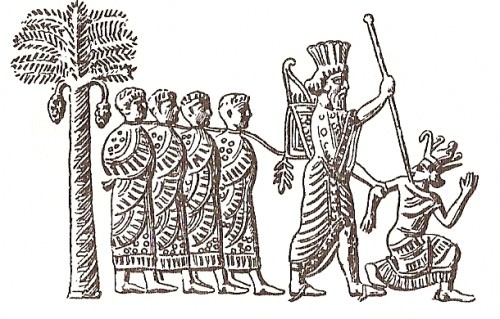
Cambyses II of Persia
Whether the details of this story are all true, the Persian army marched on Egypt in 525 BCE and met the forces of Psamtik III at the city of Pelusium. The city was heavily defended and Cambyses II understood he was probably facing heavy losses. He had long been an admirer of Egyptian culture, however, and knew of their deep devotion to cats and respect for animals.
He, therefore, ordered his men to round up cats and as many animals as they could find, and to also paint the image of Bastet, the Egyptian cat goddess, on their shields. The Persians drove the animals toward the city while raising their shields and demanding the Egyptian surrender. The defenders, not wishing to have the animals harmed and fearing lest they offend Bastet, complied; and Egypt fell to the Persians.
Although Egypt prospered under Persian rule, and the Persians respected the culture and the Egyptian religion, the title of God's Wife of Amun was abolished. The high priests of Amun now served the Persian kings and there was no longer an Egyptian royalty of any real power to confer the position on their daughters or to worry about the power of the priesthood in Egypt. The office of God's Wife of Amun was revived by the Nubian kings later, but after the massacre of the priests of Amun in 285 BCE by the king Ergamenes, it fell out of use, and the cult of Amun itself finally disappeared with the rise of Christianity.
Achaemenid Empire › Antique Origins
Definition and Origins

East of the Zagros Mountains, a high plateau stretches off towards India. While Egypt was rising up against the Hyksos, a wave of pastoral tribes from north of the Caspian Sea was drifting down into this area and across into India. By the time the Assyrians had built their new empire, a second wave had covered the whole stretch between the Zagros and the Hindu Kush. Some tribes settled, others retained their semi-nomadic lifestyle. These were the Iranian peoples.
NOMADIC TRIBES
Like all nomadic peoples lacking police and law courts, a code of honour was central to the Iranian tribes, and their religious beliefs differed from those of farming people. Whereas the farmers of Egypt and Mesopotamia had converted nature gods into city guardians, the Iranians had begun distilling them into a few universal principles. Zoroaster, who lived some time around 1000 BCE, drove this process. For him, the only god was the creator, Ahura Mazda, bringer of asha – light, order, truth; the law or logic by which the world was structured. Even those who were not practising Zoroastrians grew up shaped by a culture that valued simple ethical ideas such as telling the truth.
BOOK EXTRACT
Atlas of Empires
by Peter DavidsonCYRUS ’S MULTICULTURALISM MADE AN ENDURING IMPERIAL PEACE A REAL POSSIBILITY AND DEFINED THE WAY LATER EMPIRES SOUGHT TO ACHIEVE STABLE RULE.
In some areas, one tribe would manage to gather a collection of other tribes under its leadership. The Medes were one such.They built a capital at Ecbatana ('meeting place') in the eastern Zagros from where they extended their power. In 612 BCE, Cyaxares, King of the Medes, stormed Nineveh with the Chaldeans, after which he pushed into the north-west. In 585 BCE, the Medes were fighting the Lydians on the Halys river when a solar eclipse frightened both sides into making peace. Soon afterwards, Cyaxares died leaving an empire of sorts to his son Astyages (585–550 BCE).
One of the regions whose tribes paid tribute to the Medes was Persia, which lay south-east of Ecbatana, beyond Elam. There were around 10 or 15 tribes in Persia, of which one was the Pasargadae. The leader of the Pasargadae always came from the Achaemenid clan, and, in 559 BCE, a new leader was chosen: Cyrus II ('the Great').

Tomb of Cyrus the Great
CYRUS II
We are told that Cyrus was the grandson of Astyages on his mother's side, but that did not stop him wanting to shake off the Median yoke. By 552 BCE, he had formed the Persian tribes into a federation and begun a series of uprisings. When the inevitable showdown with his grandfather came in 550 BCE, the Medes mutinied and joined Cyrus to march on Ecbatana.
Cyrus took the title 'Shah ['King'] of Persia' and built a capital on the site of his victory, which he called Pasargadae, after his tribe. Winning the Medes over had landed Cyrus with a vague, sprawling empire of countless different peoples, however. He faced cultural diversity, suspicion, and outright hostility. Lydia and Chaldean Babylon had agreements with the Medes; neither felt comfortable about a Persian takeover.
Lydia was won because Cyrus did not play by the rules. After an indecisive battle near the Halys river one autumn, King Croesus (c. 560–c. 546 BCE) returned to Sardis, expecting to resume fighting in the spring according to custom. But Cyrus followed him home and captured Sardis itself, Lydia's capital and richest of the Ionian cities. A century earlier, Lydia had minted the first coins, making Ionia a hub of commerce. Now all this fell to Cyrus.
As for Croesus himself, it seems Cyrus may have spared his life, again against all precedent. Cyrus developed a reputation for sparing conquered rulers so he could ask their advice on how best to govern their lands. How much of this reputation was warranted is hard to know, but before Cyrus no one would have wanted it anyway; it would have been a sign of weakness.
EMPIRE OF MANY NATIONS
Cyrus, by contrast, saw cooperation as a strength, particularly when it came to securing the main prize: Babylon. Rather than trying to take the world's greatest city by force, Cyrus fought a propaganda campaign to exploit the unpopularity of its king, Nabonidus. Babylon's traditions would be safer with Cyrus, was the message. The gates were opened and palm fronds were laid before him as he entered the city.
Once in Babylon, Cyrus performed the religious ceremonies Nabonidus had neglected and returned confiscated icons to their temples around the country. These acts enabled Cyrus to claim legitimate rule in Babylon; rule sanctioned by the Babylonian gods. He then explained what place this would take in his empire: his would be an empire based, in effect, on a kind of contract between himself and the various peoples in his care. They would pay their tribute and he would ensure all were free to worship their own gods and live according to their customs.

Empire of Cyrus the Great
The exiled Jews were allowed to go home and given money towards the building of a new temple in Jerusalem. This earned Cyrus a glowing write-up in the Old Testament as well as providing him with a useful buffer state against Egypt. Cyrus's multiculturalism made an enduring imperial peace a real possibility at last and defined the way later empires sought to achieve stable rule. It was obvious to Cyrus that this was the only way he could hope to hold on to his conquests, but his was a vision only someone from outside the civilizations of the river valleys, with their intense attachments to local gods, could have conceived.
KING OF KINGS
Cyrus's son and successor Cambyses II (529–522 BCE) added Egypt to the Persian Empire, but then a revolt broke out at home, led, it seems, by a Median priest posing as Cambyses's brother, whom Cambyses had secretly murdered. Cambyses hurried back but died on the way, leaving one of his generals, a distant relative, to step in. His name was Darius. Darius I('the Great') killed the pretender to the throne, but uprisings were now breaking out all over and he found himself having to re-establish Cyrus's conquests. Backed by the army and the noble clans of Persia, grown rich from imperial rule, Darius regained the Empire and extended it into the Indus Valley, a prize worth several times more in tribute than Babylon.
Darius realized that if the Empire were to work, it needed efficient organization. He divided it into 20 satrapies, or provinces, each paying a fixed rate of tribute to Persia. Each satrapy was run by a centrally appointed satrap, or governor, often related to Darius. To prevent the satrap building a power base, Darius appointed a separate military commander answerable only to him.Imperial spies known as the 'king's ears' kept tabs on both and reported back to Darius through the postal service – the Empire was connected by a network of roads along which couriers could change horses at stations spaced a day's travel apart.
Darius took much of this structure from the Assyrians, simply applying it on a larger scale, but his use of tribute was something new. Previously, tribute had been essentially protection money paid to avoid trouble, but Darius treated it as tax. He used it to build a navy and embarked on massive public-spending programmes, pumping money into irrigation works, mineral exploration, roads, and a canal between the Nile and the Red Sea.
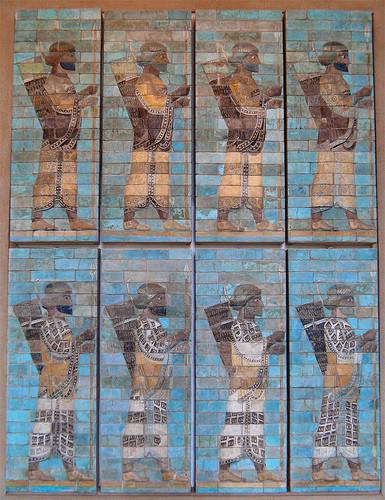
Ranks of Immortals
He also established a common currency, which made working far from home much easier. Darius now brought together teams of craftsmen from all over the Empire to build, under the direction of Persian architects, an imperial capital at Persepolis.Here he could keep his gold and silver in a giant vault (which soon became too small) and show off the multi-ethnic scope of his empire. Persepolis became a display case for the artistic styles of just about every culture within the Empire, held in a frame of Persian design. It was a visualization of Cyrus's idea of empire.
But Darius never acknowledged Cyrus. He seems to have had a chip on his shoulder about not belonging to Cyrus's branch of the Achaemenid clan. As he outstripped Cyrus's achievements, he began to carry himself in an ever more exalted manner, dropping the title Shah for the grander Shahanshah ('King of Kings'). Like Persepolis, however, this followed directly from Cyrus's vision. Cyrus had played the part of Babylon's king when he entered the city, but his concept of empire demanded a ruler who stood above all kings linked to the interests of any one community. It required a king of kings.
HUMILIATION & DECADENCE
Darius's later rule saw trouble in the Mediterranean. In 499 BCE there was a Greek revolt in Ionia. After eventually quashing it, Darius's fleet sailed to punish Athens for backing the rebels, only to encounter a surprise defeat. If the Persian administrative machine were not to look dangerously weak, the Greeks would have to be taught a lesson. But when Darius raised taxes to fund a rearmament drive, he provoked unrest in more important areas such as Egypt.
It fell to Darius's son Xerxes I (486–465 BCE) to restore order in Egypt and take up the Greek question. Xerxes carried himself more loftily still than Darius and, with two great empire builders to follow, had even more to prove. But he lacked their cultural sensitivity. When tax increases produced riots in Babylon in 482 BCE, Xerxes sacked the city, destroyed the temple, and melted down the solid gold statue of Marduk, three times the size of a man. With it went Babylon's greatness.
Marduk's gold allowed Xerxes to begin assembling his forces to crush the Greeks in 480 BCE. Forced into battle too soon, however, he suffered a worse humiliation than his father. After that, Xerxes seems largely to have withdrawn into the luxury of his court and harem. When Cyrus entered Babylon he had aped the behaviour of a Mesopotamian king for public consumption, but now the private lives of Persian rulers took Mesopotamian form. Shut up in opulent isolation, the later Achaemenids played out an increasingly gaudy pantomime of harem intrigue and palace assassination.
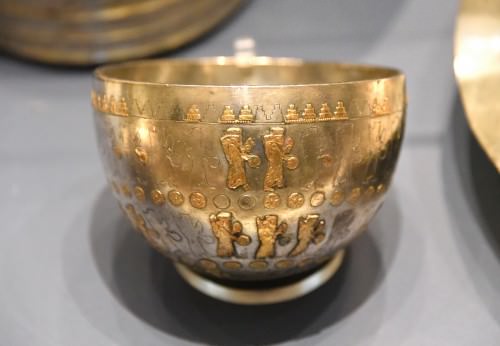
Achaemenid Silver Drinking Bowl
The empire Cyrus and Darius had built was strong enough to weather this slide into decadence for 200 years, but gradually it took its toll. Satraps carved out their own islands of power. Inflation began to bite as taxes kept rising. Even the multiculturalism of the Empire, initially its great strength, had its drawbacks; the huge army was a bewildering ragbag of troops all trained and equipped according to their own traditions, all speaking different languages.
In 401 BCE, Cyrus the Younger, Satrap of Lydia, Phrygia, and Cappadocia, staged a coup against his brother Artaxerxes II (404–358 BCE) with the help of 10,000 Greek mercenaries who returned home when the coup failed. The information they brought back paved the way for the triumphant arrival of Alexander the Great in 334 BCE.
Persia had been the first real empire, an empire with an organizational structure developed from a realistic idea of how to govern different subject peoples. It defined the role of an emperor and set a template for future empires from the Romans to the British. When Alexander came to replace the dying Persian Empire with a vision of his own, he held the example of Cyrus in the front of his mind.
MAP
LICENSE:
Article based on information obtained from these sources:with permission from the Website Ancient History Encyclopedia
Content is available under License Creative Commons: Attribution-NonCommercial-ShareAlike 3.0 Unported. CC-BY-NC-SA License